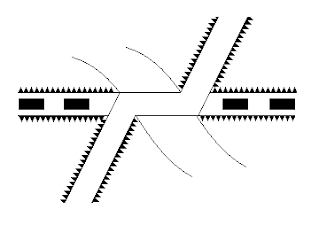Practice Test: Question Set - 03
1. Subtense bar is an instrument used for
- (A) Levelling
- (B) Measurement
of horizontal distances in plane areas
- (C) Measurement
of horizontal distances in undulated areas
- (D) Measurement
of angles
2. Volume of the earth work may be calculated by
- (A) Mean areas
- (B) End areas
- (C) Trapezoidal
- (D) All the
above
3. Tacheometric formula for horizontal distances using horizontal sights can also suitable be employed for inclined sights through θ by multiplying
- (A) The
constants by sin2θ
- (B) The
constants by cos2θ
- (C) The
constants by cosθ
- (D) The
multiplying constant by cos2θ and additive constant by cosθ
4. Pick up the correct statement from the following:
- (A) The
directions of plumb lines suspended at different points in a survey are not
strictly parallel
- (B) In
surveys of small extent, the effect of curvature may be ignored and the level
surface of the earth is assumed as horizontal
- (C) In
surveys of large extent, the effect of curvature of the earth must be
considered
- (D) All the
above
5. In levelling operation
- (A) If
second reading is more than first, it represents a rise
- (B) If first
reading is more than second, it represents a rise
- (C) If first
reading is less than second, it represents a fall
- (D) Both (b) and
(c)
6. Over-turning of vehicles on a curve can be avoided by using
- (A) Compound
curve
- (B) Vertical
curve
- (C) Reverse
curve
- (D) Transition
curve
7. Which of the following introduces an error of about 1 in 1000 if 20 m chain is used?
- (A) Length
of chain 20 mm wrong
- (B) One
end of the chain 0.9 m off the line
- (C) One end of
chain 0.9 m higher than the other
- (D) All the
above
8. Chain surveying is well adopted for
- (A) Small areas
in open ground
- (B) Small areas
with crowded details
- (C) Large areas
with simple details
- (D) Large areas
with difficult details
9. Two contour lines, having the same elevation
- (A) Cannot
cross each other
- (B) Can cross
each other
- (C) Cannot unite
together
- (D) Can
unite together
10. The conventional sign shown in below figure represents a
- (A) Bridge
carrying railway below road
- (B) Bridge
carrying road below railway
- (C) Bridge
carrying road and railway at the same level
- (D) A level
crossing
11. Which of the following statements is incorrect?
- (A) Error due to
refraction may not be completely eliminated by reciprocal levelling
- (B) Tilting
levels are commonly used for precision work
- (C) The last
reading of levelling is always a foresight
- (D) All of the
above statements are incorrect
12. In levelling operation,
- (A) The first
sight on any change point is a back sight
- (B) The second
sight on any change point is a fore sight
- (C) The line
commences with a fore sight and closes with a back sight
- (D) The line
commences with a back sight and closes with a foresight
13. The length of a traverse leg may be obtained by multiplying the latitude and
- (A) Secant of
its reduced bearing
- (B) Sine of its
reduced bearing
- (C) Cosine of
its reduced bearing
- (D) Tangent of
its reduced bearing
14. While working on a plane table, the correct rule is:
- (A) Draw
continuous lines from all instrument stations
- (B) Draw short
rays sufficient to contain the points sought
- (C) Intersection
should be obtained by actually drawing second rays
- (D) Take maximum
number of sights as possible from each station to distant objects
15. The vertical angle between longitudinal axis of a freely suspended magnetic needle and a horizontal line at its pivot, is known
- (A) Declination
- (B) Azimuth
- (C) Dip
- (D) Bearing
Next Tests:

